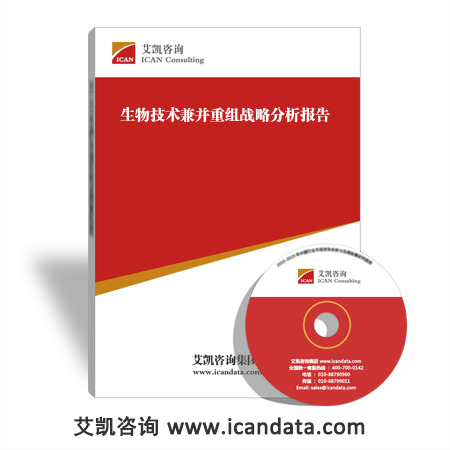数据来源与研究方法:
- 对行业内相关的专家、厂商、渠道商、业务(销售)人员及客户进行访谈,获取最新的一手市场资料;
- 艾凯咨询集团对长期监测采集的数据资料;
- 行业协会、国家统计局、海关总署、国家发改委、工商总局等政府部门和官方机构的数据与资料;
- 行业公开信息;
- 行业企业及上、下游企业的季报、年报和其它公开信息;
- 各类中英文期刊数据库、图书馆、科研院所、高等院校的文献资料;
- 行业资深专家公开发表的观点;
- 对行业的重要数据指标进行连续性对比,反映行业发展趋势;
- 通过专家咨询、小组讨论、桌面研究等方法对核心数据和观点进行反复论证。
报告简介:

摘要
M&A activity is gaining momentum - Biotech companies and niche biopharmaceutical concerns have become key targets for pharmaceutical companies seeking to fill gaps in their drug pipelines, while M&As between biotech companies are also growing in number. Sales of products from biotechnology and niche biopharmaceutical companies are out-performing sales of traditional, small molecule pharmaceuticals in the global market, making this an attractive sector.
目录及图表
iii
Table of Contents
Biotech M&A Trends
Executive Summary 8
Introduction 8
M&A trends 2003-2008 9
Biotech M&A strategies 9
Case Studies 10
Strategies for success 11
Future trends 12
Chapter 1 Introduction 14
Summary 14
Introduction 15
Scope of report 16
Definition of M&As 18
Biotech an attractive target 20
Industry trends 21
Product development costs 22
M&A drivers 23
Challenges & opportunities 24
For sellers 24
For buyers 25
Future trends 25
Chapter 2 M&A trends 2003-2008 28
Summary 28
Introduction 29
Geographical breakdown of deals 30
Location of acquiring companies 30 HEALTHCARE
Biotech M&A Strategies
Deal assessments, trends and future prospects
By Jeanette Marchant
Table of Contents
ii
Jeanette Marchant
Jeanette Marchant provides consultancy services to market intelligence organizations,
specialist healthcare publishers and healthcare companies. She has 30 years' experience
in writing on international pharmaceutical, medical technology and related industries,
including 19 years as an editor at PJB Publications Ltd. She is the author of numerous
market reports for the pharmaceutical and medical technology industries.
Copyright © 2008 Business Insights Ltd
This Management Report is published by Business Insights Ltd. All rights reserved.
Reproduction or redistribution of this Management Report in any form for any
purpose is expressly prohibited without the prior consent of Business Insights Ltd.
The views expressed in this Management Report are those of the publisher, not of
Business Insights. Business Insights Ltd accepts no liability for the accuracy or
completeness of the information, advice or comment contained in this Management
Report nor for any actions taken in reliance thereon.
While information, advice or comment is believed to be correct at the time of
publication, no responsibility can be accepted by Business Insights Ltd for its
completeness or accuracy.
iv
Indian M&As fuelled by international expansion 32
Location of target companies 33
Deal values 35
Total M&A values 36
Average deal values 37
Average deal values by leading acquirers 38
Average deal values by target country 40
Conclusions 41
Chapter 3 Biotech M&A strategies 44
Summary 44
Introduction 45
Key target attributes 45
Factors influencing deals 47
Approved product deals 48
Late-stage product deals 50
Technology platform deals 51
Geographical expansion 52
Geographical trends 53
Acquisition valuation 54
Payment mechanism 56
The seller's perspective 57
Chapter 4 Case studies 60
Summary 60
Introduction 61
Case Study 1: Actelion/Axovan & CoTherix 62
Axovan acquisition 63
CoTherix acquisition 63
Conclusion 64
Case Study 2: Antisoma/Xanthus 65
Xanthus acquisition 66
Xanthus' assets 67
Impact of deal on Antisoma 68
Conclusion 69
Case Study 3: Forest Labs/Cerexa 70
Cerexa acquisition 71
Conclusion 72
Case Study 4: Solvay Pharmaceuticals/Innogenetics 72
v
Innogenetics 73
Bidding war 74
Conclusion 75
Case Study 5: Avant Immunotherapeutics/Celldex Therapeutics 76
The merged company 77
Conclusion 78
Chapter 5 Strategies for success 80
Summary 80
Introduction 81
Target selection 81
Funding acquisitions 82
Getting value from a sale 82
Restructure for sale 83
Case study: Nabi Biopharmaceuticals 84
Case study: Innogenetics 85
Myriad considering restructuring 85
The role of shareholders 86
Post M&A issues 87
Conclusion 88
Chapter 6 Future Trends 92
Summary 92
Introduction 93
Importance of M&A 94
Future drivers 95
Reverse mergers 96
M&A combinations 98
Product targets 99
Biotech industry outlook 100
Chapter 7 Appendix 101
Primary research methodology 101
Industry Survey 101
vi
MedTRACK Database 106
Additional Research 107
Glossary 108
Index 109
List of Figures
Figure 1.1: Biotech drugs in development by therapeutic category* 21
Figure 1.2: Relative importance of M&A initiatives for company success in short to mid-term
future 26
Figure 2.3: Number of M&A Deals 2003-2008 for which values are known 30
Figure 2.4: Top Locations of Acquirers of Biotech Companies 2003-2008 31
Figure 2.5: M&A trends by Indian companies 2003-2008 32
Figure 2.6: Top Locations of Biotech Targets 2003-2008 34
Figure 2.7: M&A trends by deal value 35
Figure 2.8: Total value of M&A deals ($ms), years 37
Figure 2.9: Average deal values ($ms), years 38
Figure 2.10: Trends of average value of M&A deals by country of acquirer 39
Figure 2.11: Average value of M&A deals by target location ($m), years 41
Figure 3.12: Buyers' key selection criteria 46
Figure 3.13: Key Drivers in 50 M&As 2007-2008 48
Figure 3.14: Payment mechanisms for 50 M&As 2007-2008 56
Figure 6.15: Relative importance of M&As for future company growth 94
Figure 6.16: Future trends in biotech/pharma M&A activity 98
Figure 7.17: Profile of respondents by company size 102
List of Tables
Table 1.1: Big Pharma, Japan Pharma & Biotech companies excluded from the scope of this
report 17
Table 1.2: Global biotech leading therapy classes 2007 20
Table 1.3: Biotech development costs ($m) 23
Table 2.4: Number of Biotech M&A deals included for geographical analysis 29
Table 4.5: Actelion Financial Overview 62
Table 4.6: Key late-stage products in Forest's pipeline 70
Table 4.7: Innogenetics' key diagnostic product areas 73
Table 6.8: Importance of different motivations behind M&A strategies 95
Table 7.9: Profile of respondents by company products/service offering 101
Table 7.10: Profile of respondents by core responsibility 103 Companies of all sizes have
been under increasing
commercial pressure over the
last decade to innovate or perish,
and the government has been
encouraging them to innovate by
offering tax credits, grants for R&D
and a wide range of other support
mechanisms.
Universities are a hot-bed of
innovation and the UK has many
world class research departments.
London has an impressive but
daunting academic scientific
research base and combined with
the adjoining regions of the South-
East and East of England, hosts
60% of the UK’s academic research
(ECOTEC, 2005).
The challenge for most businesses
though, is that even if they believe
that universities could help them de-
velop new products, processes or
services, they just have no way of
finding the right academic who is
able to solve their problem. This is a
clear market failure.
The solution is government-funded
LTN (London Technology Network),
which provides impartial and swift
innovation matchmaking to
the innovation core of the “Greater
South-East” of England.
The results are impressive. From
July 2004 to June 2007 LTN
assisted 3,500 substantial
discussions between industry and
academia, and supported the
conclusion of 853 deals. This
totalled more than £36 million of
targeted investment in collaborative
projects.
LTN’s regular networking events
bring business executives, university
researchers and knowledge transfer
officers together on a vast array of
sectors such as sustainable
transport, digital media, vascular
health and grid computing.
The company also helps small
businesses find development part-
ners through “technology matching”,
through which a firm’s needs are
sent anonymously to targeted expert
academics. Academic responses are
presented to the company who then
choose who they want to work with.
A key part of this success has been
LTN’s expanded reach beyond
London to include the East and
South-East of England. Collectively,
the three regions have a bigger
university cluster than anywhere
else in Europe, but with a
geographic spread of sectors that
makes cross-regional technology
matchmaking a must. London has
among the best engineering schools
in the world, for instance, but few
engineering companies are situated
in the capital.
LTN’s success stories include:
Electronic Arts, which is based in
Surrey, was matched with experts at
University College London, while
Cambridgeshire-based laboratory
services firm HFL Limited was
introduced to experts at St George’s
and Royal Holloway universities.
London firm CDO2, was matched
with experts at the University of
Surrey, while EISAI found the right
consultants at the University of
Oxford.
LTN offers an additional free service
to companies and academics based
in London and the South-East of
England, to help develop their
discovery or find research partners.
Enterprise Europe Network spans
the UK region and 40 European
countries, and provides access to a
vast online database, where partic-
pants can search (by keyword) for
technology offers/requests in their
field, and also submit their technol-
ogy to possible European partners.
LTN, as part of the Network, has
successfully connected
regional and European
companies and
researchers as well as
holding brokerage events
attracting
attendees from across
the Continent.
London Technology Network:
Helping companies succeed
through technology-intensive
collaboration
Peter Reid,
CEO, LTN
17 Linhope Street, NW1 6HT
P: 44 (0) 870 765 7602
F: 44 (0) 870 765 7606
W: www.LTNetwork.org
LTN’s recent events have
showcased the latest
technology breakthroughs
in topics including Diabetes
and Related Disorders,
Pain Management, Regen-
erative Medicine, Ambient
Assisted Living, Nutrition
and Health, Personalised
Medicine and Micro-Elec-
tronics in Medical Devices.
Companies who have at-
tended events and bene-
fited directly from LTN’s
technology matchmaking
include: Takeda UK; GE
Healthcare; Pfizer; Glaxo-
SmithKline and Trigen.
BiotechM
















